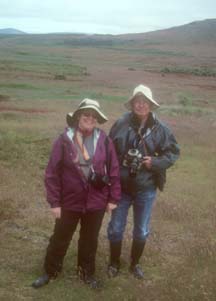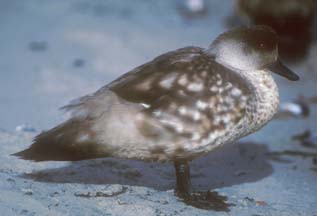
(Click on any image below for a larger version)
Friday, January 19: Carcass Island, Falkland Islands
We returned to the Hanseatic, which hauled up the anchor and headed northeast to Carcass Island. Carcass Island is named after the ship HMS Carcass. The sun was in front of us and I found it impossible to shake the feeling that we were going south.
 Shortly after leaving the harbor a small pod of
Peale's Dolphins could be seen approaching the ship, leaping
clear out of the water every several seconds.
Shortly after leaving the harbor a small pod of
Peale's Dolphins could be seen approaching the ship, leaping
clear out of the water every several seconds.
Blue-eyed Shags flew over the ship from behind, madly flapping their relatively small wings.
 When they
caught the ridge lift generated by the ship they were able to
stretch out their wings and glide for a few seconds. It must be a
rare and wonderful experience for them to get to glide.
When they
caught the ridge lift generated by the ship they were able to
stretch out their wings and glide for a few seconds. It must be a
rare and wonderful experience for them to get to glide.
 After
lunch, the ship passed through the narrow strait between West
Falkland Island and tiny West Point Island (shown here). Dolphins
were frolicking near the shore of West Point Island. The wind was
rising, but the air temperature was quite comfortable.
After
lunch, the ship passed through the narrow strait between West
Falkland Island and tiny West Point Island (shown here). Dolphins
were frolicking near the shore of West Point Island. The wind was
rising, but the air temperature was quite comfortable.
The Hanseatic rounded a point and headed up a channel alongside Carcass Island. At the other end of the island it wheeled around and dropped anchor off of a sandy beach. Through binoculars, numerous small black specks on the beach could be seen to be penguins.
The ship's crew lowered the Zodiacs into the water alongside the ship. We put our wellies back on and rode a Zodiac in to the shore.
 The
ship's photographer was waiting at the shore to shoot pictures of
the occupants of each Zodiac.
The
ship's photographer was waiting at the shore to shoot pictures of
the occupants of each Zodiac.
On shore we were led through a Magellanic Penguin rookery. It was very different from the Rockhopper rookery.
 Magellanic Penguins dig burrows in the sandy
soil under the grass near the shore. They lack the head crest of
the Rockhopper Penguins and have a white ring around a black
face. The lie around or stand grouped together in the short
grass.
Magellanic Penguins dig burrows in the sandy
soil under the grass near the shore. They lack the head crest of
the Rockhopper Penguins and have a white ring around a black
face. The lie around or stand grouped together in the short
grass.
Environmental Research Unit, Falkland Islands background information about the Magellanic Penguin.
 Upland Geese graze on the grass around the Penguin burrows.
Upland Geese graze on the grass around the Penguin burrows.
 Farther inland the topography is dominated by
Tussock Grass, which grows in large clumps. Magellanic Penguins
nest in the clumps of tall grass. The birds in the lake are
Patagonia Crested Ducks.
Farther inland the topography is dominated by
Tussock Grass, which grows in large clumps. Magellanic Penguins
nest in the clumps of tall grass. The birds in the lake are
Patagonia Crested Ducks.
 A Falkland Thrush landed on a fence post just a short distance
away from us and looked us over carefully.
A Falkland Thrush landed on a fence post just a short distance
away from us and looked us over carefully.
Environmental Research Unit, Falkland Islands background information about the Falkland Thrush.
 Fearless little Tussock Birds hopped around our feet as they fed
on the grass and small flowers. They would jump right on our feet
if we stood still long enough. Tussock Bird is the local name for
the Blackish Cinclodes.
Fearless little Tussock Birds hopped around our feet as they fed
on the grass and small flowers. They would jump right on our feet
if we stood still long enough. Tussock Bird is the local name for
the Blackish Cinclodes.
Environmental Research Unit, Falkland Islands background information about the Tussock Bird.
The destination of our hike was the McGill settlement, a couple of miles along the shore from our landing point.
 The Hanseatic pulled up its anchor and steamed
around the headland to meet us at the bay near the settlement.
The Hanseatic pulled up its anchor and steamed
around the headland to meet us at the bay near the settlement.
 Here are Dad and Debbie hiking on Carcass
Island. After a short climb up a shallow slope we came to a
primitive road.
Here are Dad and Debbie hiking on Carcass
Island. After a short climb up a shallow slope we came to a
primitive road.
 We followed the road past a Gentoo Penguin rookery. Gentoo
Penguins have orange beaks and orange feet. They have white spots
on either side of their head that are joined by a white stripe
over the top of the head. They don't build nests or dig burrows.
We followed the road past a Gentoo Penguin rookery. Gentoo
Penguins have orange beaks and orange feet. They have white spots
on either side of their head that are joined by a white stripe
over the top of the head. They don't build nests or dig burrows.
Environmental Research Unit, Falkland Islands background information about the Gentoo Penguin.
 They stand, clustered in colonies.
They stand, clustered in colonies.
 As we approached the colony, a group of Gentoo
Penguins that had been on the other side of the trail from the
colony came running down the hill. They charged right through the
middle of our group, as fast as their stubby little penguin feet
could carry them, to join the other penguins.
As we approached the colony, a group of Gentoo
Penguins that had been on the other side of the trail from the
colony came running down the hill. They charged right through the
middle of our group, as fast as their stubby little penguin feet
could carry them, to join the other penguins.
 A Magellanic Penguin scratched his beak.
A Magellanic Penguin scratched his beak.
Caracaras and Turkey Vultures were riding the ridge lift along the hill above the trail.
 We continued to pass Magellanic Penguin burrows
and grazing Upland Geese all the way to the settlement.
We continued to pass Magellanic Penguin burrows
and grazing Upland Geese all the way to the settlement.
 Near the settlement we came across a family group of Kelp Geese
with a pair of downy, gray chicks. The male Kelp Goose is snow
white and looks a lot like a common barnyard goose.
Near the settlement we came across a family group of Kelp Geese
with a pair of downy, gray chicks. The male Kelp Goose is snow
white and looks a lot like a common barnyard goose.
Environmental Research Unit, Falkland Islands background information about the Kelp Goose.
We worked our way down to the shoreline for the last part of the hike.
 Three Caracaras were standing on a rocky outcrop a few yards
offshore.
Three Caracaras were standing on a rocky outcrop a few yards
offshore.
Link to the Falklands Conservancy pages about the Caracara.
Some of the earlier arrivals were already boarding the Zodiacs to return to the ship. We found our way to the main residence where the Rob McGill and his wife had set up an afternoon tea. There was a big table in the middle of the living room that was overloaded with cakes, pastries, and toast. The toast was thickly layered with butter, like icing on a cake.
 As we ate our teacakes in the back yard Tussock Birds boldly
investigated our packs and walked across our feet.
As we ate our teacakes in the back yard Tussock Birds boldly
investigated our packs and walked across our feet.
 A dried-out sheep carcass had been placed on the roof of the shed
for the Falkland Thrushes to feed on.
A dried-out sheep carcass had been placed on the roof of the shed
for the Falkland Thrushes to feed on.
 A stand of trees had been planted as a
windbreak between the main house and the shoreline. Black Crowned
Night Herons were building large nests of sticks and small
branches in the trees.
A stand of trees had been planted as a
windbreak between the main house and the shoreline. Black Crowned
Night Herons were building large nests of sticks and small
branches in the trees.
Environmental Research Unit, Falkland Islands background information about the Black Crowned Night Heron.
 Patagonia Crested Ducks were feeding along the
water's edge.
Patagonia Crested Ducks were feeding along the
water's edge.
Environmental Research Unit, Falkland Islands background information about the Patagonia Crested Duck.
 A few solitary Magellanic Penguins were
trolling the water of the bay. They pedaled themselves through
the water with their head submerged, looking for small fish and
other prey.
A few solitary Magellanic Penguins were
trolling the water of the bay. They pedaled themselves through
the water with their head submerged, looking for small fish and
other prey.
 A Pied Oystercatcher with a long, bright red
beak was investigating the rocks on the shore, looking for small
invertebrates to eat.
A Pied Oystercatcher with a long, bright red
beak was investigating the rocks on the shore, looking for small
invertebrates to eat.
Environmental Research Unit, Falkland Islands background information about the Pied Oystercatcher
 While we were taking pictures of the waterfowl
along the shore, a pod of dolphins appeared in the bay, leaping
out of the water around the Zodiacs.
While we were taking pictures of the waterfowl
along the shore, a pod of dolphins appeared in the bay, leaping
out of the water around the Zodiacs.
 The Zodiac drivers turned to follow
the dolphins, which leaped and cavorted in the wakes from the
small boats. Debbie and I got into the next Zodiac to leave
shore, but the dolphins seem to have had their fun and were
nowhere to be seen.
The Zodiac drivers turned to follow
the dolphins, which leaped and cavorted in the wakes from the
small boats. Debbie and I got into the next Zodiac to leave
shore, but the dolphins seem to have had their fun and were
nowhere to be seen.
 Table of
Contents
Table of
Contents Send a message to Brian.